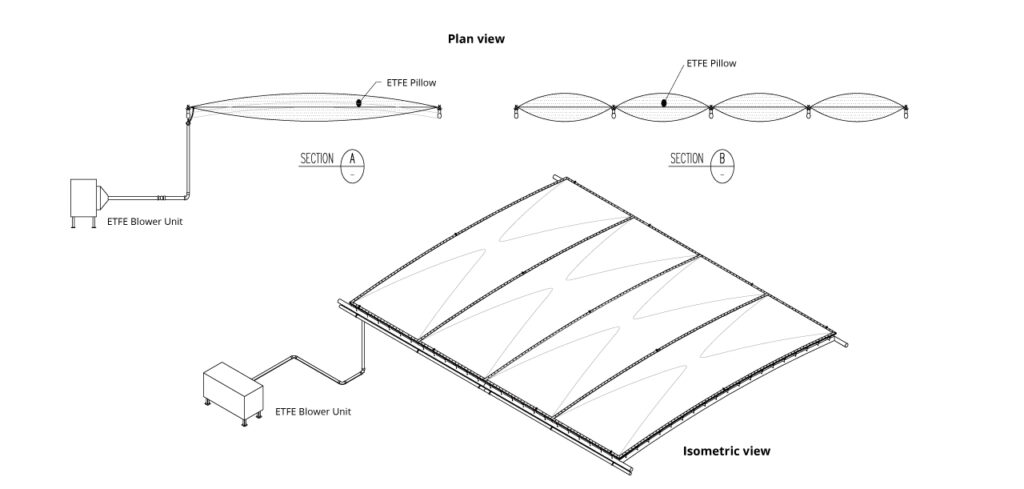Need to brush up on your lingo or just curious about what tensile membrane designers and engineers discuss over lunch?
Listed below are some of the most common fabric structure industry terms.
A common design of an ETFE Roof involved creating “pillows”. Two layers of ETFE are inflated with a series of pneumatic inflation units to around 5 or 6 psi.
The low-pressure air pillows provide thermal insulation and structural stability against wind, rain and hail.

The feature of fabric wherein the physical properties and behaviour are not the same in all directions. If material has a been woven with fibres all in one direction, the strength and stretch characteristics will be different if tensioned with or against the fibre direction. Materials with uniform physical properties are referred to as Isotropic.
A surface with positive (Gaussian) curvature in one principal direction and negative (Gaussian) curvature in the other. A saddle shaped surface.
The uncoated fabric, also known as greige goods.
Oriented at 45 degrees to the warp and fill directions of the fabric.
Taken along two concurrent orthogonal directions, usually principal directions.
Doughnut-shaped plate attached to a cable ear plate to reinforce the pinhole and allow a thinner plate.
Seam created when the two pieces of fabric being joined together are butted together with a strip twice the width of the seam.
Fabric or steel cone at the top of an umbrella.
A membrane covering a rigid structural frame constructed to provide sun and weather protection. A canopy can also refer to the skin of an umbrella.
The curve theoretically formed by a perfectly flexible, uniformly dense cable under its own self-weight when supported only at its ends.
Associated Terms;
- Catenary Cable; Steel cables that run through the pockets on the perimeter of a tension fabric structure. The shape of the cable follows that of the pocket, which is typically curved with a ratio of 1:10. The length of the cable is determined by the project engineer supplying the fabric patterning. The thickness of the cable is determined by the engineer who calculates the reaction loads at the cable ends.
- Catenary Cable Fitting; Device attached to the end of a cable to allow a connection to another member. Fittings are swaged.
- Catenary Cable Pocket; Edge treatment in which the fabric is folded over on itself to form a pocket in which a catenary cable can be installed.
Device used with a cable stud end or a threaded rod to form a pinned connection that is somewhat adjustable.
A material applied to a fabric for waterproofing and protection of the fabric yarns.
The coating adhesion refers to the strength of the bond between the substrate of a fabric and the coating.
Covered Outdoor Learning Area. A custom fabric structure shade and weather structure in a school or early-learning environment. Usually a single span arched canopy, a COLA is perfect for sports courts, assembly areas or playgrounds.
The size difference required to calculate the area of membrane to fabricate. The fabric pieces are smaller in their unstressed condition than the actual installed size (due to tensioning).
The tendency of a material to deform over time when under the influence on constant mechanical pressure. The rate of membrane’s creep can be effected by exposure time, exposure temperature and the applied tension load.
Relieve the tension or stress in a membrane.
The configuration that a tensioned fabric surface assumes when boundary conditions, pre-stress level, and pre-stress distribution are defined.
A woven cloth made of many yarns, fibres or filaments.
The shorter yarns of a fabric, which usually run at right angles to the warp yarns. Also known as weft yarns.
A fluoropolymer is a fluorocarbon-based polymer, made up of multiple carbon–fluorine bonds and offer a high resistance to solvents, acids, and bases. A well known fluoropolymer is Polytetrafluoroethylene (PTFE).
Excessive, uncontrolled movement, usually caused by the interaction between the structure and wind. This occurs when the fabric lacks sufficient pre-stress.
The process of determining the equilibrium shape of a fabric structure.
The large concrete anchoring structure that holds the tension structure securely to the ground. The top of the footing is typically flush with the ground level. The footing is comprised of a matrix of steel rebar that is referred to as a cage. The concrete is poured into the hole in the ground that holds the cage. The anchor bolts get placed into the top of the footing at their precise location as indicated in the working drawings. A certified engineer must calculate the size of the footings. The size of the footing must contain enough weight to hold down the tension structure for the wind loads in the area.
The steel cable is used to support the structural integrity of the steel frame. It may be attached at the end of the steel struts to hold them together and resist them from movement relative to each other. Unlike catenary cables, the lengths are calculated by a straight point-to-point dimension. The engineer will need to determine the thickness by calculating the maximum stress on the cable.
A hyperbolic paraboloid (saddle-shaped) geometric shade sail is known as a hypar (or hy-par). Generally constructed with two high posts and two low posts, the fabric is tensioned in a saddle-shape. Common uses for a hypar design are smaller shaded areas, such as pools or playgrounds. Multiple hypar sails can be combined to create a larger coverage, such as Carpark Shade Covers.
Brand name for the solid PVC cord used at a “rope edge”. Rope edges provide strength and a surface to evenly distribute fabric tension forces.
Seam created when the two pieces being joined are overlapped by the width of the seam.
A measure of the portion of light striking a fabric surface that passes through the fabric and into the space to provide natural light.
The principal upright in a tension structure.
The fabric panels used in tension structures.
Metal plates attached to the membrane corners used for securing the membrane to the frame.
The ratio of the change in stress to the change in strain. Usually defined as a force per unit width of a membrane material.
Intersection points of the elements used to define the fabric shape in the structural analysis; these are normally given in terms of a three-dimensional coordinate system.
Reduced wind speed to account for the load averaging nature of fabrics. If ultimate design wind speeds are used on fabric structures the results can often be unconservative.
The ratio of lateral strain to longitudinal strain; may take a wide range of values due to the deformation characteristics of a woven material.
Polyvinyl chloride (also known as vinyl or PVC) is the world’s third-most widely produced synthetic plastic polymer (after polyethylene and polypropylene).
PVC is available as a woven or non-woven material, and has been a popular choice in the fabric membrane roofing industry since the early 1960s.
The stress state that exists in a fabric structure when it is not acted upon by service loads; usually induced by the boundary conditions of the fabric membrane.
The inverse of the magnitude of (Gaussian) curvature at a location on a membrane surface. The magnitude is typically considered in two principal directions. The orientation of the principal directions and their magnitude may vary continuously over the surface.
A reinforcing matrix of steel rods used to strengthen concrete.
An additional layer of fabric placed in an area of high stress to protect the main fabric.
Edge treatment in which the edge of the fabric is folded over on itself and a rope or cord is incorporated in the fold to increase the strength of the clamped fabric.
Method of field joining large fabric panels utilizing clamping hardware.
A tube of fabric, which loosely contains a structural element such as a cable, rod, etc.
Type of cable fitting in which the strands of the cable are opened inside the fitting and molten lead is poured into the fitting to secure the cable.
A steel cable that is used to stabilize the mast in response to the forces created by wind loads. The stay cables are used to resist movement of the structure relative to the earth. One end of the cable will typically connect to the end of the steel frame near the fabric connection. The other end will terminate to a sturdy section of the mast or a footing in the ground.
Type of cable fitting in which a sleeve fits over the outside of the cable and the sleeve is compressed around the cable to form a tight fit.
A surface with positive (Gaussian) curvature in both principal directions. A bubble shaped surface.
A portmanteau of Tension and Integrity, a tensegrity structure indicates that the integrity of the structure derived from the balance of tension members, not the compression struts. Originally coined by Buckminster Fuller, an American architect, designer and inventor, a tensegrity structure essentially uses it’s own components under tension to create stability.
Using tensegrity theory in the design of fabric architecture can create incredible light-weight, yet strong and durable shade structures.
Device used in a simple cable loop end to secure the cable and bear against the pin. Thimbles are usually used with shackles.
An additional coating sometimes used on fabric for greater protection against UV degradation or for ease of cleaning purposes (i.e. Ferrari’s PVDF branded T2, Dupont’s PVF branded Tedlar).
Threaded device used with cables or rods to allow adjustment.
The deterioration of a fabric under long-term exposure to sunlight. Using a top finish on the fabric will help prevent the UV degradation.
Taken along one direction, usually a principal direction.
Vdes is a wind-speed measurement used in structural engineering. It refers to the wind speed when measure at right angles to the structural axis. Vdes is the ultimate design wind speed for a specific structure calculated to AS1170.2.
The Vierendeel truss is a structure where the members are not triangulated but form rectangular openings, and is a frame with fixed joints that are capable of transferring and resisting bending moments. As such, it does not fit the strict definition of a truss (since it contains non-two-force members): regular trusses comprise members that are commonly assumed to have pinned joints, with the implication that no moments exist at the jointed ends. This style of structure was named after the Belgian engineer Arthur Vierendeel,[26] who developed the design in 1896.
The utility of this type of structure in buildings is that a large amount of the exterior envelope remains unobstructed and can be used for windows and door openings. In some applications this is preferable to a braced-frame system, which would leave some areas obstructed by the diagonal braces.
Direction on the fabric that relates to the long straight yarns.
The long straight yarns are referred to as Warp Yarns.
The process of making a fabric from yarns passing alternately over and under each other.
Direction on the fabric that relates to the shorter yarns, typically prepindicular to the warp. The shorter yarns are referred to was Weft Yarns or Fill Yarns.
Connection component, usually steel, for the attachment of cables andlor fabric. If may be free-floating or connected to other membranes.
The conveying of liquid by capillary action along and through the yarns of the base fabric.
U-shaped bolt with special insert, specifically designed to clamp a wire rope to itself when forming a loop end for temporary cables.
Furrows or ridges on the normally smooth surface of a fabric structure, which are indicative of extreme differences between the principal stresses typically resulting from a lower stress perpendicular to the furrow.
A number of fibers grouped together to make a thicker strand for weaving. They may be twisted together or parallel to each other.

